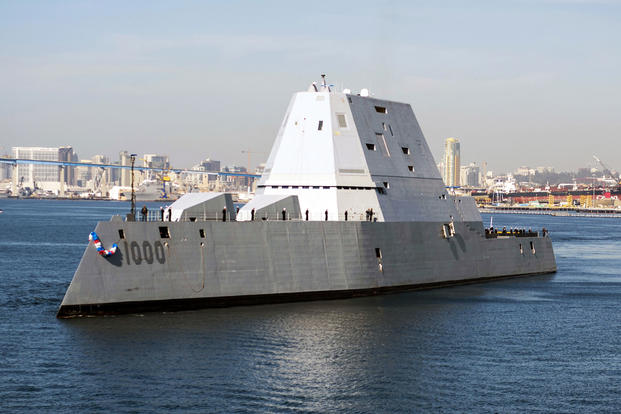A Washington, D.C., defense think tank has a modest proposal: Move all three of the Navy's planned DDG-1000 Zumwalt-class destroyers to South Korea.
That's one of the major recommendations to emerge from a new report by the Center For Strategic and Budgetary Assessments on a future fleet architecture for the Navy.
The 138-page document, formally released last week, calls for a future fleet of 340 ships, slightly fewer than the service's own projected requirement of 355. It promotes the expanded use of unmanned vessels to increase the Navy's capabilities; recommends the development of a four-ship amphibious ready group construct; and pushes for a new, lighter class of aircraft carriers in place of big-deck amphibs.
And while CSBA agrees with the service's assessment that it needs only three of the $4 billion Zumwalt destroyers, it needs to move them out of the current designated homeport of San Diego, according to the report.
If the three ships were based in the Republic of Korea, they could provide command-and-control capabilities for the East China Sea and littoral fires against North Korea, the report states.
The Navy has yet to comment on these proposals. On Wednesday, Rear Adm. Jesse Wilson Jr. and Charles Werchado, director and deputy director of the Navy's Assessment Division, will appear before the House Armed Services Committee, where they will address the report's recommendations, said Navy spokeswoman Lt. Kara Yingling, who declined to comment ahead of the hearing.
The USS Zumwalt, the first ship of the class, is currently undergoing combat testing in its homeport of San Diego, Navy spokeswoman Lt. Chelsea Irish told Military.com. Its future homeport has yet to be finalized.
"Long-range planners constantly assess whether ships and aircraft are being used effectively and efficiently, and part of that evaluation is where the Zumwalt-class destroyers should be homeported," she said. "That said, it will ultimately be a Department of the Navy decision. The Navy continually monitors force readiness and capabilities to provide the most capable maritime force possible to [U.S. Pacific Command]."
But the authors of the report told Military.com their forward-basing proposal is both practical and well-suited to the various capabilities of the Zumwalt class.
Bryan Clark, the report's head author and a former special assistant to then-Chief of Naval Operations Adm. Jonathan Greenert, said he and Greenert had visited the port of Chinhae, South Korea, where the U.S. has a small Navy base. He said the port has the ability to host additional ships.
"There's places in Korea where you could base this ship without a lot of investment," he said.
Because of its lower-signature stealthy design, Clark said, the ship is ideal for the littoral environment around Korea, where it could conduct fire support. In coastal waters, it could conduct anti-submarine warfare missions or counter-special operations forces missions aimed at North Korea, which is developing its SOF capability.
"Also, because it's so large and it's got so much capacity that's not really tapped right now, it could house command-and-control for surface forces in the East China Sea," he said. "It offers a lot of capabilities that would be very useful in that particular region, and if you try to deploy it from San Diego, then you're less able to take advantage of them."
The USS Zumwalt was commissioned in October. The two other planned ships, the Michael Monsoor and the Lyndon B. Johnson, are under construction, with the christening of the Monsoor set to take place in 2018.
The development of the futuristic ship has already hit a series of speed bumps. The Navy initially planned to purchase 32 of the ships, but had to cut the number down to just three due to unexpected costs associated with the new technologies built into the destroyers.
More recently, Navy officials revealed that the ammunition for the ship's cutting-edge Long Range Land Attack Projectile guns was too costly to buy at $800,000 per round, sending the Navy back to the drawing board to determine what weapons to use on the Zumwalt class.
It's possible the service is already considering its own strategy for moving the ships to South Korea, or at least nearby. Last April, then-Defense Secretary Ash Carter told reporters the future plan is to base all three Zumwalt ships with the Pacific fleet as part of the ongoing rebalance to that region of the world, though he did not say where the ships would be based or when they would get there.









